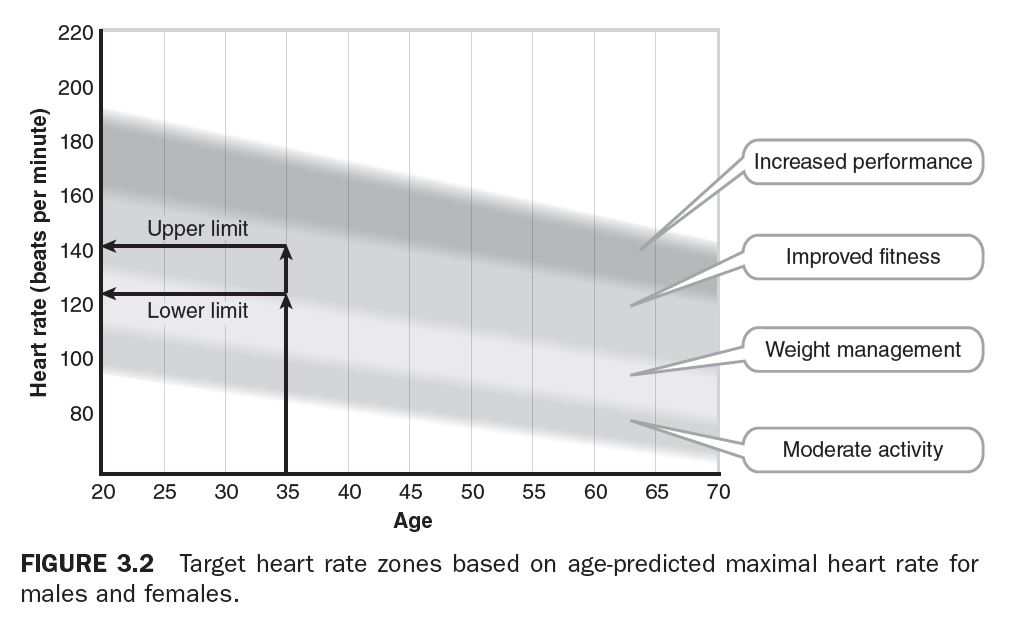Sport Performance and Heart Rate
by NSCA's Guide to Tests and Assessments
Kinetic Select
July 2020
This article reviews the use of heart rate as a way to program cardiovascular exercise.
The following is an exclusive excerpt from the book NSCA's Guide to Tests and Assessments, published by Human Kinetics. All text and images provided by Human Kinetics.
The intensity of training can be closely monitored to control and hopefully optimize the training regimen and adaptations (Franklin 2000). For example, if an athlete has a low degree of cardiorespiratory fitness, it might be appropriate to have her maintain a pace high enough to challenge her current cardiorespiratory efficiency, but not so high that she cannot sustain the exercise. As her fitness improves over time, the relative intensity of exercise that is reflected by HR can be increased so that she is constantly pushing herself to improve. The Karvonen method of maintaining exercise intensity provides a customized upper and lower HR limit that can be used to help the athlete remain motivated and focused on maintaining a specific relative intensity. If used religiously, monitoring HR can be a great way to quantify the difficulty of workouts over time, giving the coach or trainer some additional objective insight as to how the athlete is feeling.
Many practitioners establish target heart rate by simply calculating a percentage of the age-predicted maximal heart rate, although this method is not as robust as the Karvonen method. At first glance, this method appears rudimentary and generic because the formula does not consider anything but age. However, the exercise intensity established using this method is indeed specific to the person because each person requires a unique amount of work to reach any given target heart rate. Therefore, a sedentary 20-year-old and an athletic 20-year-old may have the same predicted values, but the exercise intensity needed to reach these values would be considerably different.
Figure 3.2 demonstrates the exercise heart rate range for a 35-year-old who wants to improve fitness (green zone). Because this person is not fit enough to handle the intensity required to increase performance (red zone), he should probably ease off on the intensity and choose a level more appropriate for his current state of fitness. Over time, the level can be adjusted, but it is probably best to be conservative when prescribing intensity so that the client remains motivated and develops a base of fitness to build on.

An athlete may use these target heart rates to cycle the intensity of training in a given workout or throughout the training season. Consider a soccer midfielder who has the physiological challenge of executing anaerobic bursts of speed throughout a game that lasts well over an hour. The training program for this athlete should most likely involve days focused on endurance as well as days that include high-intensity interval training.
Heart rate can be used in both of these situations. For long endurance training, the athlete may want to maintain a certain moderate intensity by monitoring his heart rate over the course of a long run. As cardiorespiratory improvements are gained over time, his heart rate will decrease at any given speed providing evidence that a faster pace may be needed to initiate additional improvements in fitness. Conversely, when the athlete engages in anaerobic interval training, heart rate can still be a valuable tool. Although heart rate is not an indicator of performance during sprinting activities, it can be an indicator of recovery between sprints. As the season approaches, the trainer can adjust the recovery interval to provide a customized challenge for the athlete or to slowly introduce a game-like physiological challenge that will translate into improved performance.
Developed by the National Strength and Conditioning Association (NSCA), this comprehensive text offers extensive information on performance-related assessment and testing for strength and conditioning professionals in measuring key fitness components. The book is available in bookstores everywhere, as well as online at the NSCA Store.
- Privacy Policy
- Your Privacy Choices
- Terms of Use
- Retraction and Correction Policy
- © 2025 National Strength and Conditioning Association